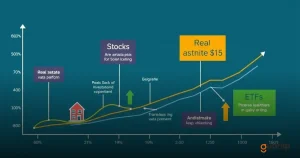When it comes to investment portfolio strategies, understanding the basics is crucial for financial success. Diversification significantly minimizes risk and maximizes returns.
Different types of investment portfolios provide unique benefits, and knowing the right tools and resources can elevate your investment game. Ready to dive into strategic methods that can potentially enhance your financial growth?
Why diversification is key
Implementing diversification in your investment portfolio involves spreading investments across a variety of asset classes. This can include stocks, bonds, real estate, and mutual funds. By doing this, you are effectively reducing the risk associated with putting all your financial eggs in one basket. If one asset class underperforms, the performance of other classes can help cushion the blow.
Additionally, diversification allows you to tap into the potential growth of different sectors. For instance, if the technology sector experiences a boom, having tech stocks in your portfolio can significantly boost your returns. However, if the tech sector encounters a downturn, investments in more stable asset classes like bonds or real estate can provide balance.
It’s also critical to consider geographic diversification. Allocating part of your portfolio to international markets can protect against country-specific economic downturns. Historically, no single stock or sector consistently leads the market, making diversification a prudent approach to long-term growth.
Asset allocation
Choosing the right balance between different types of investments is fundamental. This process, known as asset allocation, depends on your risk tolerance, financial goals, and investment horizon. For example, younger investors may opt for a higher percentage of stocks due to their growth potential, while those nearing retirement might prioritize bonds for their relative stability.
Types of investment portfolio strategies

When it comes to investment portfolios, there are multiple types that cater to different financial goals and risk tolerance levels. Knowing the various types can help investors make informed decisions.
1. Growth portfolio: This type focuses on capital appreciation. It typically includes stocks of companies expected to grow at an above-average rate compared to other firms. High-risk with potentially high returns.
2. Income portfolio: Aimed at generating regular income through dividends or interest payments. It usually comprises bonds, dividend-paying stocks, and other income-generating securities. Lower-risk but with steady returns.
3. Value portfolio: Focuses on stocks that are undervalued in the market. Investors believe that these stocks will provide a good return when the market adjusts to their true value. Moderate risk and usually a mid to long-term strategy.
4. Balanced portfolio: Combines a mix of stocks and bonds to balance risk and return. This portfolio aims to achieve growth while providing a buffer against losses. Suitable for investors looking for a moderate risk level.
5. Index portfolio: Replicates a specific market index like the S&P 500. It’s passive and aims to match the market performance. Lower management fees and lower risk, suitable for a hands-off investment approach.
6. ESG (Environmental, social, and governance) portfolio: Focuses on companies that meet certain environmental, social, and governance criteria. This socially responsible investment might come with varying degrees of risk and return.
Risk management techniques
Managing risk is crucial in achieving financial success. Investors must employ several strategies to mitigate potential losses.
First, diversification is essential, spreading investments across different asset classes to reduce exposure to any single risk.
Second, understanding the risk tolerance is vital; assessing one’s ability to endure market fluctuations helps shape a balanced portfolio.
Third, employing hedging strategies using options or futures can safeguard against market downturns.
Finally, maintaining adequate cash reserves ensures liquidity in volatile markets. These techniques help create a resilient investment portfolio, crucial for financial success.
Long-term vs short-term strategies

When assessing investment portfolio strategies, it’s vital to comprehend the distinction between long-term and short-term strategies.
Long-term strategies typically involve holding assets for several years, sometimes even decades. This approach suits those aiming for significant appreciation over time, riding out market volatility.
Short-term strategies, on the other hand, focus on quicker gains, often within a year or less. These strategies demand frequent market analysis and swift decision-making.
Each method has distinct advantages and drawbacks. Long-term investments benefit from compounded growth and reduced tax implications. However, investors need to be patient and endure market fluctuations. Conversely, short-term strategies can capitalize on market trends, potential high returns, but come with higher risks and possible tax penalties.
Consider your financial goals and risk tolerance when choosing between these strategies. Integrating both could potentially offer balanced growth and liquidity in your investment portfolio.
Tools and resources for investors
Software and platforms
Investors can leverage a variety of software and platforms to manage their portfolios effectively. Tools like portfolio trackers help in keeping tabs on different investments and their performance. Platforms such as Personal Capital and Morningstar provide robust analysis and insights.
Educational resources
There are numerous educational resources available for investors looking to enhance their strategies. Websites like Investopedia and Khan Academy offer free tutorials and articles that cover a wide range of topics from basic investing principles to advanced strategies.
Market analysis tools
Access to reliable market analysis tools can significantly impact investment decisions. Tools like Bloomberg Terminal and Yahoo Finance offer real-time data, financial news, and in-depth analysis. These resources help investors stay informed about market trends and make educated decisions.
Community forums
Engaging with online communities can offer valuable insights and support. Platforms such as Reddit, specifically subreddits like r/investing, provide a space for investors to discuss strategies, share experiences, and ask for advice. Being part of a community can help in gaining different perspectives and understanding various investment approaches.
Final considerations
In conclusion, building a strong investment portfolio requires careful consideration of diversification, asset allocation, and risk management. By spreading investments across different asset classes and sectors, investors can balance potential risks and rewards, ensuring a smoother ride through market fluctuations.
Choosing the right strategy—whether it’s growth, income, or balanced—depends on individual goals and risk tolerance. By aligning the portfolio with long-term financial objectives, investors can work towards achieving steady, sustainable returns over time.
Leveraging tools, resources, and educational platforms enhances decision-making and keeps investors informed. Staying proactive and adaptable will help navigate the ever-changing market landscape, ensuring continued growth and financial success.




